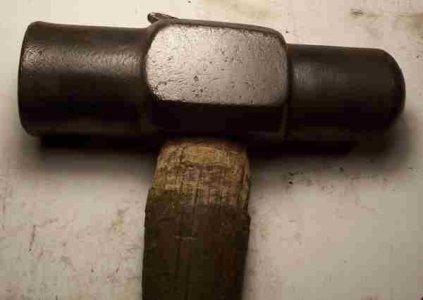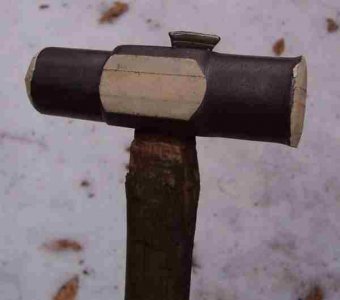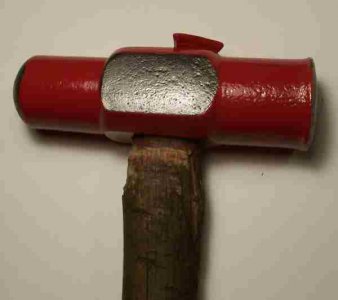Cool story, thanks for sharing. Funny how we have tools from way back that just work for us, feel good in your hand, and become the thing you instinctively grab for. If they came from relatives past, you think about them occasionally as you use it - makes you smile.
-
Welcome back Guest! Did you know you can mentor other members here at H-M? If not, please check out our Relaunch of Hobby Machinist Mentoring Program!
You are using an out of date browser. It may not display this or other websites correctly.
You should upgrade or use an alternative browser.
You should upgrade or use an alternative browser.
An Unwanted Project
- Thread starter Robo_Pi
- Start date
- Joined
- Feb 13, 2017
- Messages
- 2,138
Looks like the thread is getting hijacked. More traffic about the hammer than fixing the tractor. Good save there, by the way.
The hammer looks, to me, like a very old version of a B&O, with the end cut back. I have no idea what the B&O means, it's what the millwrights call it. Has a long handle, like a sledge. One side, the hammer(?), is for striking with a heavy sledge. The other side is a pin punch. Varying sizes depending on the application. The long handle to keep the user/ holder clear of sparks and glancing blows by the guy slinging the hammer. Usually a large sledge, 16 or more pounds.
When the pin punch gets beyond economical use, such as bent or broken, it often ends up cut back and made into a (relatively small) sledge itself. You got to watch the balance when you grind it back. But it makes a very good hand sledge, like a drilling hammer but a little heavier.
Working in the "hot" side of a steel mill gives a lot of insight into many crafts. The casters where I was made a "slab" that was 10 inches thick, by anywhere from 3 to 8 feet wide. At 40 inches a minute, downtime was quite costly and many corners were cut to keep it going. We went through B&Os like candy bars. And broken handle sledges. No time to replace a handle, just grab another and keep going. Electricians ended up with a lot of tools that way.
The hammer looks, to me, like a very old version of a B&O, with the end cut back. I have no idea what the B&O means, it's what the millwrights call it. Has a long handle, like a sledge. One side, the hammer(?), is for striking with a heavy sledge. The other side is a pin punch. Varying sizes depending on the application. The long handle to keep the user/ holder clear of sparks and glancing blows by the guy slinging the hammer. Usually a large sledge, 16 or more pounds.
When the pin punch gets beyond economical use, such as bent or broken, it often ends up cut back and made into a (relatively small) sledge itself. You got to watch the balance when you grind it back. But it makes a very good hand sledge, like a drilling hammer but a little heavier.
Working in the "hot" side of a steel mill gives a lot of insight into many crafts. The casters where I was made a "slab" that was 10 inches thick, by anywhere from 3 to 8 feet wide. At 40 inches a minute, downtime was quite costly and many corners were cut to keep it going. We went through B&Os like candy bars. And broken handle sledges. No time to replace a handle, just grab another and keep going. Electricians ended up with a lot of tools that way.
Bill Hudson
Last edited:
- Joined
- Feb 18, 2016
- Messages
- 451
B&O might stand for Baltimore & Ohio railroad? My dad worked for the Union Railroad which was part of US Steel in Pittsburgh. But I've seen B&O railroad cars in their yards too. It was mostly hopper cars hauling coal, iron ore, and of course flat cars hauling steel products too. So it could be that this hammer came from the railroad. That's the most likely source. So this hammer was probably my dad's then. 

- Joined
- Feb 1, 2015
- Messages
- 9,622
The hammer looks like a cross between a rounding hammer and a ball peen hammer. Both have a domed face which blacksmiths use to efficiently draw metal. Typical ball peen hammers have relatively small radius and are used for upsetting rivet faces. They aren't very efficient when drawing a bar of metal though. Rounding hammers have a something like a 2-1/2 to 3" radius on the dome and are great for drawing metal.
The hammer might have been used for heading large rivets
The tractor looks very similar to my 1950 ford 8N. I took my safety chains off years ago. My tractor has an auxiliary stabilizer bar which is mounted on an extension of the right hand fender bracket on the same axis as the lift arms. This forms a triangle which prevents side to side motion of the lift arm. I always have either a drawbar or an implement attached to the arms so the left hand lift arm is constrained from side to side motion as well.
The hammer might have been used for heading large rivets
The tractor looks very similar to my 1950 ford 8N. I took my safety chains off years ago. My tractor has an auxiliary stabilizer bar which is mounted on an extension of the right hand fender bracket on the same axis as the lift arms. This forms a triangle which prevents side to side motion of the lift arm. I always have either a drawbar or an implement attached to the arms so the left hand lift arm is constrained from side to side motion as well.
- Joined
- Feb 18, 2016
- Messages
- 451
The tractor looks very similar to my 1950 ford 8N. I took my safety chains off years ago. My tractor has an auxiliary stabilizer bar which is mounted on an extension of the right hand fender bracket on the same axis as the lift arms. This forms a triangle which prevents side to side motion of the lift arm. I always have either a drawbar or an implement attached to the arms so the left hand lift arm is constrained from side to side motion as well.
Yeah, I'll need to look into making some kind of stabilizer bar. As it is now it just yanks on one chain and then the other going back and forth. It's no wonder it broke with all that yanking going on.
- Joined
- Feb 18, 2016
- Messages
- 451
More Hammer highjacking,...
With all the talk about the hammer I was starting to get embarrassed about how much I've been neglecting it. So,....
Wire brush,...

Masking tape

New Paint.

Ta da! Daddy and grandpa would be proud.
Actually I've been wanting to do this for some time. It's easier to find when it's painted bright red.
With all the talk about the hammer I was starting to get embarrassed about how much I've been neglecting it. So,....
Wire brush,...

Masking tape

New Paint.

Ta da! Daddy and grandpa would be proud.

Actually I've been wanting to do this for some time. It's easier to find when it's painted bright red.
- Joined
- Feb 18, 2016
- Messages
- 451
- Joined
- Feb 18, 2016
- Messages
- 451
I'll probably do something like that. It would be nice to tighen this hitch up. I have a Case tractor also. The Case has a 2-point hitch and a solid tongue draw bar. It's also quite a bit larger. Unfortunatley it's currently broken as well. That'll be a project for another day.


